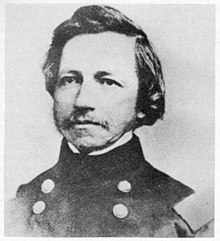Amiel Weeks Whipple
Amiel Weeks Whipple | |
|---|---|
 Amiel Weeks Whipple | |
| Born | October 21, 1817 Greenwich, Massachusetts |
| Died | May 7, 1863 (aged 44) Washington, D.C. |
| Place of burial | Proprietors' Cemetery, Portsmouth, New Hampshire |
| Allegiance | United States of America Union |
| Service/ | United States Army Union Army |
| Years of service | 1841–1863 |
| Rank | |
| Battles/wars | American Civil War |
Amiel Weeks Whipple (October 21, 1817 – May 7, 1863)
Biography
Whipple was born to David and Abigail Brown (Pepper) Whipple in
In 1848 Whipple was assigned to the United States Boundary Commission, tasked with surveying the new boundary between the US and Mexico resulting from the Mexican–American War. For a time, he served as the interim chief surveyor for the commission until William H. Emory was named to the position. Heading east from San Diego, the survey parties traveled through some of the most rugged and remote terrain in the country. Compounding the difficulty was the extreme desert heat and hostile Apache Indians. Whipple accomplished his assigned surveys in spite of these challenges and was promoted to first lieutenant on April 24, 1851.[1] By 1853 his survey work was complete and his reports had been written.[3]
In 1853 Congress authorized the Pacific Railroad Surveys to select the best route for a transcontinental railroad. Whipple was directed to lead one of those surveys along the 35th parallel from Fort Smith, Arkansas to Los Angeles. The Whipple expedition left Fort Smith on July 15, 1853, with a group of seventy men including soldiers, teamsters, and scientists. Among the scientists were John Milton Bigelow, a medical doctor and botanist; Jules Marcou, a Swiss geologist; and Balduin Möllhausen, a German artist and a protege of Alexander von Humboldt. Whipple's party made good progress through Indian Territory (now Oklahoma), the Texas panhandle and the New Mexico Territory, reaching Albuquerque on October 5.[1][4] After Albuquerque, they were joined by frontiersman Antoine Leroux who helped to guide the surveyors through the most difficult part of the journey to California. They reached California on February 7 after a near-disastrous crossing of the Colorado River then crossed the Mojave Desert and reached Los Angeles on March 20, 1854.[5][6]
The findings of the Whipple expedition along with the other transcontinental survey parties were published by the government in a massive twelve-volume report, the Pacific Railroad Reports. In addition to reports on topography, geology, botany and zoology, Whipple wrote a lengthy essay on the southwestern Indian tribes that the expedition had encountered.[5]
Whipple was promoted to captain in 1855 and then assigned to supervise efforts to open the Great Lakes to navigation by larger vessels, deepening channels through the St. Clair flats and the St. Mary's River. He was also commander of the lighthouse districts from
At the outbreak of the Civil War, Whipple served for a time under General
Commemoration
Whipple was memorialized with the naming of two forts,
Numerous plant taxa were named in his honor, including the genus Whipplea and species Hesperoyucca whipplei, and Sclerocactus whipplei.
The fish Cyprinella whipplei Girard, 1856 was named after him.[8]
See also
- List of American Civil War generals (Union)
- List of Massachusetts generals in the American Civil War
Notes
- ^ a b c d e f Anderson, TSHA
- ^ a b Dictionary of American Biography, 1936
- ^ Werne, 2007
- ^ McDougall, TSHA
- ^ a b c Goetzmann, 1979
- ^ a b c Beidleman, 2006
- ^ Gudde, 1969
- ^ Christopher Scharpf & Kenneth J. Lazara (22 September 2018). "Order CYPRINIFORMES: Family LEUCISCIDAE: Subfamilies LAVINIINAE, PLAGOPTERINAE and POGONICHTHYINAEs". The ETYFish Project Fish Name Etymology Database. Christopher Scharpf and Kenneth J. Lazara. Archived from the original on 9 December 2021. Retrieved 9 December 2021.
- ^ International Plant Names Index. Whipple.
References
- Anderson, H. Allen. "Whipple, Amiel Weeks". Handbook of Texas Online. Texas State Historical Association.
- Beidleman, Richard G. (2006). California's Frontier Naturalists. University of California Press.
- Goetzmann, William H. (1979). Army Exploration in the American West 1803-1863. University of Nebraska Press.
- Gudde, Erwin G. (1969). California Place Names (3rd ed.). University of California Press.
- McDougall, Mary Gordon, ed. (1988). Through Indian Country to California: John P. Sherburne's Diary of the Whipple Expedition, 1853-1854. Stanford University Press. ISBN 9780804714471.
- McDougall, Mary Gordon. "Whipple Expedition". Handbook of Texas Online. Texas State Historical Association.
- Werne, Joseph Richard (2007). The Imaginary Line: A History of the United States and Mexican Boundary Survey 1848-1857. Texas Christian University Press.
- "Amiel Weeks Whipple". Dictionary of American Biography (DAB). Charles Scribner's Sons. 1936.
![]() This article incorporates text from a publication now in the public domain: Jenkins, Regina Randolph (1912). "Amiel Weeks Whipple". Catholic Encyclopedia. Vol. 15.
This article incorporates text from a publication now in the public domain: Jenkins, Regina Randolph (1912). "Amiel Weeks Whipple". Catholic Encyclopedia. Vol. 15.
External links
- "Major General Amiel Weeks Whipple". Whipple Website.
